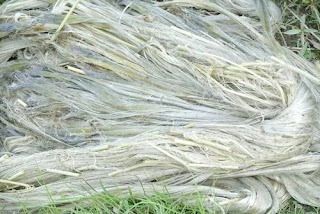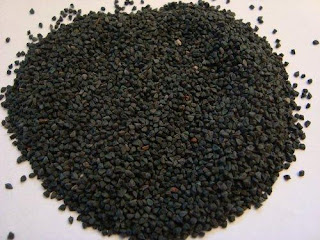Cultivation of Jute (Corchorus spp.) in India
Introduction;
Uses of Jute Fiber ;
4) The jute stalks stripped of fiber are used as fuel
Classification of Jute Crop ;
The cultivated varieties of jute (Corchorus sp.)are classified into two types of cultivated species:
(1) Corchorus capsularis:
Climatic Requirements for Jute Cultivation ;
1) Jute thrives best under a warm and humid climate with temperatures ranging from 24 to 37°C, the optimum being around 34°C.
Soil Requirement for Jute Cultivation ;
1) Jute can be grown on all kinds of soils from clay to sandy loam but loamy alluvial soil suits it most.
Important Varieties of Jute Crop ;
Some new varieties of jute evolved at the Jute Agricultural Research Institute, Barrackpore, and released for cultivation on farmers’ fields are as follows:
|
S.No |
Name of Variety |
State(s) of release |
Yield q/ha |
Salient traits notified |
|
1 |
JRO 632 (Baisakhi Tossa) |
W.B. |
30-32 |
Suitable for late sowing induces premature flowering if sown before mid-April, pods shattering type. |
|
2 |
J RO 878 (Chaitali tossa) |
W.B. |
30-32 |
Suitable for early (mid-March) sowing, pods non-shattering type, better fiber fineness. |
|
3 |
JRO 7835 (Basudev) |
W.B. |
32-34 |
Pods non-shattering, suitable for early (mid-March) sowing, can withstand waterlogging to some extent at a later stage of growth. |
|
4 |
JRO 524 (Navin) |
W.B. |
32-40 |
Pods non-shattering, sowing during the middle of March does not induce premature flowering. It is least susceptible to yellow mite pests and is resistant to root rot diseases in high rainfall areas. It rets better than other olitorius varieties and extraction is easy. |
|
5 |
TJ 40 (Mahadev) |
Maharashtra |
25 |
Premature flowering resistance-absent, pod dehiscence-present ; seed color-green |
|
6 |
JRO 3690 (Savitri) |
W.B. |
30-33 |
Pods shattering type, better fiber quality, suitable for late sowing. |
|
7 |
KOM 62 (Rebati) |
Odisha |
30.4 |
Premature flowering resistance-absent, pod dehiscence-present ; seed color-steel grey |
|
8 |
JRO 66 (Golden jubilee Tossa) |
W.B. |
35-40 |
Pods non-shattering type, fiber quality TD2 grade, ideal for mid-April to early May sowing. |
|
9 |
JRO 8432 (Shakti Tossa) |
W.B. |
35-40 |
Suitable for early (mid-March) sowing, premature flowering resistant, non-shattering pod. |
|
10 |
JRO 128 (Surya) |
W.B. |
32-38 |
Pods non-shattering type can be sown from mid-March to end of April. Very good fiber quality. |
|
11 |
S 19 (Subala) |
W.B. |
30-35 |
Suitable for early (mid-March) sowing, resistant to premature flowering, tolerant to major pests and diseases, finer fiber quality with lesser lignin content. |
|
12 |
JRO 204 (Suren) |
W.B. |
36-38 |
Tall, cylindrical stem, non-lodging type, non-shattering pod, resistance to premature flowering |
|
13 |
AAUOJ 1 (Tarun) |
Assam |
36 |
Non-shattering pod, broader leaf with green longer stipule, resistance to premature flowering, better biotic resistance for stem rot, root rot, anthracnose, and yellow mite |
|
14 |
JBO 2003H (Ira) |
W.B. |
38 |
Resistance to premature flowering, better fiber quality, better biotic resistance to stem rot, root rot, anthracnose, and yellow mite |
|
15 |
CO 58 (Sourav) |
W.B. |
34 |
The suitable time of sowing is mid- March, pods are non- shattering type, resistance to premature flowering, better fiber quality, resistance to major pest and diseases |
|
16 |
JBO 1 (Sudhangshu) |
W.B. |
30-35 |
The suitable time of sowing is mid- March to end- April, pods are non-shattering type, low lignin content, resistant to premature flowering, better fiber quality, resistance to major pest and diseases |
|
17 |
JROM 1 (Pradip) |
W.B. |
37.4 |
The suitable time of sowing is mid- March to the end of April, Stem: Cylindrical, non-branching; Leaf color: Green, laceolate shape; Flower: Petal color; Yellow; Fruit: Pods green cylindrical, non-shattering |
|
18 |
JROG 1 (Rithika) |
W.B. |
27.93 |
The suitable time of sowing is mid- March to end- April, non-shattering pod, resistance to premature flowering, resistance to root rot and stem rot disease, fiber quality is good, tolerance of abiotic stresses, |
|
19 |
JRO 2407 (Samapti) |
W.B |
33.82 |
The suitable time of sowing is early March, pods are non-shattering type, low lignin content, resistance to premature flowering, better fiber quality, resistance to major pest and diseases. |
|
20 |
KRO 4 (Gouranga) |
W.B |
29.61 |
Adapted to Tossa jute growing especially, West Bengal, Assam, Bihar and Odisha for mid-March to mid-May sowing. Tolerant to stem rot disease and insects like semi looper, apion, BHC, and yellow mite. |
|
21 |
BCCO 6 (Kisan Pat) |
W.B |
28.35 |
Coppery red stem variety with better fiber tenacity (21.18 g/tex) and fineness (2.81 tex), recommended for the entire Tossa jute growing states for sowing in the 2nd fortnight of April to May. |
Source; ICAR
Rotations and Mixed Cropping in Jute Crop ;
a) In irrigated areas; jute can admirably fit in multiple cropping following intensive crop rotations may be followed.
(1) Jute-paddy-wheat
b) In rainfed areas; the following crop rotations may be followed with advantage.
(1) Jute-paddy
c) Intercropping;
Field Preparation for Jute Cultivation;
1) Jute requires a clean, clod-free field with fine tilth for its successful establishment.
Seed and Sowing for Jute Crop Cultivation ;
Before sowing seed should be treated with Agrosan G.N. or Ceresan at the rate of 5 gms per kg of seed against the attack of seed-borne pathogens.
1) The sowing of jute generally starts from the month of February and extends in some parts of India to the middle of June.
Manures and Fertilisers Requirement for Jute Crop;
1) Compost or farmyard manure, if available, should be applied at the rate of 5 to 8 tonnes per hectare and incorporated into the soil at least a month before sowing.
5) Nitrogenous fertilizers are usually top dressed in one or two installments at four to five weeks of crop age when the nitrogen requirement of the jute plant is highest.
Water Management in Jute Crop;
1) Jute is generally grown under rainfed conditions.
Weed Control and Thinning in Jute Crop;
1) The weed infestation in jute is maximum up to the sixth week of crop age.
Diseases and Pest Management ;
Disease Management ;
a) Seedling Blight
This disease is caused by the fungus Macrophomina phascoli. The fungus being seed-borne in nature, the seedling may initially develop black lesions on cotyledons that rot and wither, the tender stem then dries brown. Ultimately the seedlings die and the field looks blighted.
Control;
b) Root Rot;
Control; same as seedling blight
c) Stem Rot;
This disease is caused by M. Phaseoli. Though the disease is denoted by stem rot, the infection starts from leaves. The pycnospores of M. phaseoli fall on the leaf surface, germinate and the hyphal system penetrates the leaf tissue causing necrosis. The disease spreads towards the petiole and through it reaches the node of the stem. The node becomes black and the infection patch spreads upwards and downwards. Minute black dot-like bodies develop on the stem and leaf.
Control; same as seedling blight
d) Collar Rot;
This disease is also caused by M. phaseoli. The collar region of the plant, viz., four to six inches of the stem from the base is affected. A brownish-black scar-like lesion is developed which may encircle the stem.
Control Measures; same as seedling blight
e) Anthracnose of Capsulari;
This disease is caused by Colletotrichum corchorum. Tiny, moist, brownish-black spots appear on the stem which later coalesce to form a larger necrotic lesion. In an advanced stage of the disease, the necrotic become dark, dry, and cankerous. When pods are attacked, they turn brown and shrivel.
Control Measures;
f) Anthracnose of Olitorius ;
The causal organism is Colletotrichum gloeosporioides. At about the month’s stage of the crop, many dark spots become visible on When the disease is severe, necrosis goes deeper, spots coalesce to form canker, and yield is affected.
Control Measures;
The disease is caused by Physoderma corchori. The disease is found on late sown olitorius crop subject to submergence in low lying areas during monsoon. Galls may be initially green, but gradually turn pink to brown and finally rusty brown. Each infected plant may have innumerable galls, some of which coalesce to form a large blister with lacerated fibre Finally, the dead plants turn into black sticks.
Control Measures;
(1) Avoid submerged conditions.
In addition to above important diseases, there are several other diseases like Hoogli wilt, soft rot, black band or die-back, leaf mosaic, the shooty mould of pods etc., of minor importance.
2) Insect Pests Management;
a) Jute Semi-Looper;
The incidence of semi-looper starts in the middle of June and continues up to the middle of August. The caterpillars are green in colour and their length ranges from 5-8 centimetres. They attack the soft leaves of the apical region of a plant. They devoured apical leaves and cause retardation in growth in the apical region which reduces side branches.
Control Measures;
Spray Endosulfan 35 EC at the rate of 428 millilitres in 500 liters of water per hectare
b) Jute Stem Weevil ;
The incidence of jute stem-weevil starts from the seedling stage of the plant The female makes a hole at the base of the stalk of the leaf (petiole) With the help of its snout, turns and lays eggs singly in holes. After three lavs. the eggs hatch and the grub is inside the hole. The grub being stationary takes food causing wounds from within the plant and grow old day by day. The mucilagenous substance of the plant oozes out from the wounds, gets mixed with the excreta of the grubs and harden with adjoining tissues and form a knot. The quality of the fibre thus gots deteriorated.
Control Measures;
Spray crop with Endosulfan 35 EC at the rate of 428 milliliters in 500 liters of water per hectare.
c) Bihar Hairy Caterpillar;
The caterpillars in their young stages remain congregated. After two months they scatter themselves throughout the field. These caterpillars attack both capsularis as well as olitorius jute. At first, as a result of its attack, the skeleton of the leaf only remains, denuded of green color. In the later stages of growth, the whole leaf is eaten by them.
Control Measures ;
d) Tobacco Caterpillar;
Deep green caterpillars devoured the upper leaves of the plant and thereby retard the growth of the plant and induce side branches which are not desirable in jute crops.
Control Measures;
Same as for jute semi-looper.
d) Indigo Caterpillar ;
Indigo caterpillars damage the leaves of the jute plant when its age is 25. 30 days. Yellowish-green caterpillars damage young leaves. They, of course, do not damage much. At the time of thinning, the damaged plants may be uprooted.
Control Measures;
In case of severe damage spray Endosulfan 35 EC at the rate of 428 millilitres per hectare in 500 litres of water.
e) Yellow Mite ;
Yellow mite mainly attacks olitorius jute. Light yellow coloured mite with their immature stages (nymphal stages) collectively damage the apical leaves of the jute plant by piercing their stylet and sucking of the leaf juice As a result, the leaves crumple and ultimately turn coppery brown. The growth of the plant gets arrested. Thus the jute plants become weak. They prefer to remain on the undersurface of a leaf.
Control Measures;
Apply Endosulfan 35 EC at the rate of 650 millilitres in 500 litres of water per hectare or 2 litres of lime sulphur in 500 litres of water per hectare.
f) Jute Girdler;
This pest attacks olitorius jute only. The female adult cuts two rings at the apical region of the plant and lays eggs singly. The grubs grow inside the stem. The apical portion at its attack gets withered or gets detached at the gush of wind.
Control Measures;
Spray Metasystox 25 EC at the rate of 800 millilitres or Rogor 30 EC 600 millilitre in 500 litres of water per hectare.
g) Red Mite;
Red mite damages more in the month of May-June when hot humid weather is prevalent. They prefer to remain on the undersurface of the leaf and pierce their stylets to take the juice from the leaf. Yellow mites restrict their attack to upper tender leaves whereas red mites attack both younger as well as older leaves. As a result of injury, the leaves appear to be white spotted. After this, the leaves turn yellow and fall off prematurely,
Control Measures;
Apply Kelthane or Dicofol at the rate of 1100 millilitre or Morocid at the rate of 800 millilitres in 500 litres of water per hectare.
h) Root-Knot Nematode
The attack of root-knot nematode is more on the capsularis jute than on olitorius. As a result of their attack, the roots become swollen and uptake of nutrients from soil becomes less. Leaves appear light green and dull in appearance.
Control Measures;
Apply Nemagon as pre-plant at the rate of 37.5 litres per hectare irrigation water.
Harvesting of Jute Crop;
1) Jute crop may be harvested for fibre purpose at any time before flowering between 120 and 150 days after sowing.
4) Harvesting is done by cutting the plants close to the ground level with sharp sickles.
Retting;
1) Retting is a process by which the fibres in the bark get loosened and separated from the woody stalk.
3) Retting is best done in a shallow canal with slow running clear water: where such facilities are not available, tanks with a depth of about two metres are quite suitable.
Extraction;
The Yield of Jute Crop;
1) The national average is 13 quintals of fiber per hectare while with improved package and practices, it is possible to obtain 20-25 quintals of fiber yield per hectare from improved varieties.






